Consultancy Report: EIS Implementation Strategy for Pacific Steel
VerifiedAdded on 2023/04/20
|12
|3045
|488
Report
AI Summary
This report provides a consultancy service for Enterprise Information System (EIS) implementation at Pacific Steel, a New Zealand-based manufacturer of steel products. It includes a company overview, detailing its products, history, and organizational structure. The report evaluates and selects SAP ERP as the most suitable ERP system for Pacific Steel, discussing its characteristics and advantages over NetSuite ERP. Furthermore, it analyzes the sales and distribution processes, highlighting the benefits of SAP ERP in enhancing sales force management and market distribution. The report also addresses material management, contrasting conventional methods with the capabilities of SAP ERP in stock management, order fulfillment, and warehouse management. The consultancy concludes that implementing SAP ERP will resolve the issues of conventional material management and improve overall business operations for Pacific Steel.
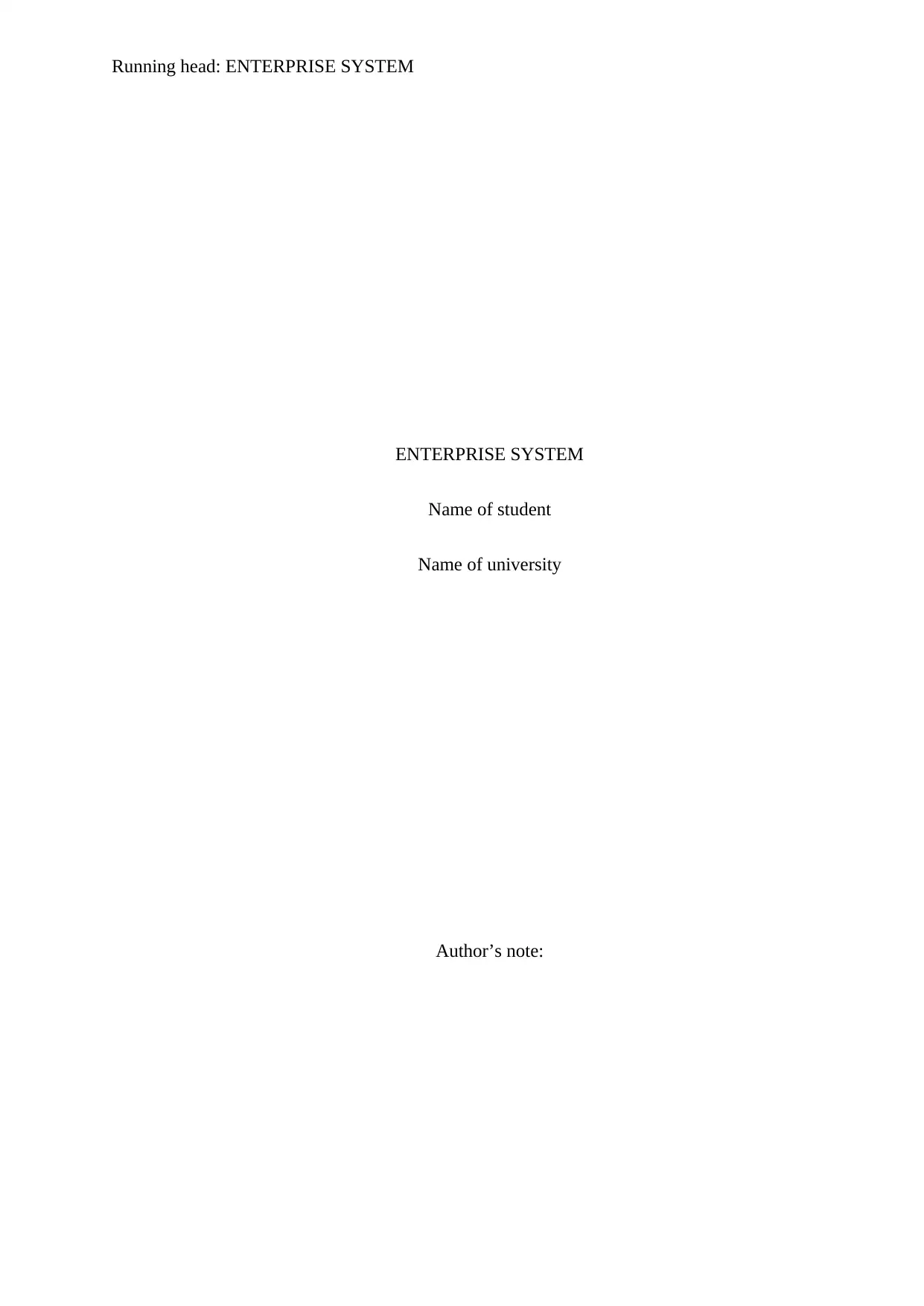
Running head: ENTERPRISE SYSTEM
ENTERPRISE SYSTEM
Name of student
Name of university
Author’s note:
ENTERPRISE SYSTEM
Name of student
Name of university
Author’s note:
Paraphrase This Document
Need a fresh take? Get an instant paraphrase of this document with our AI Paraphraser
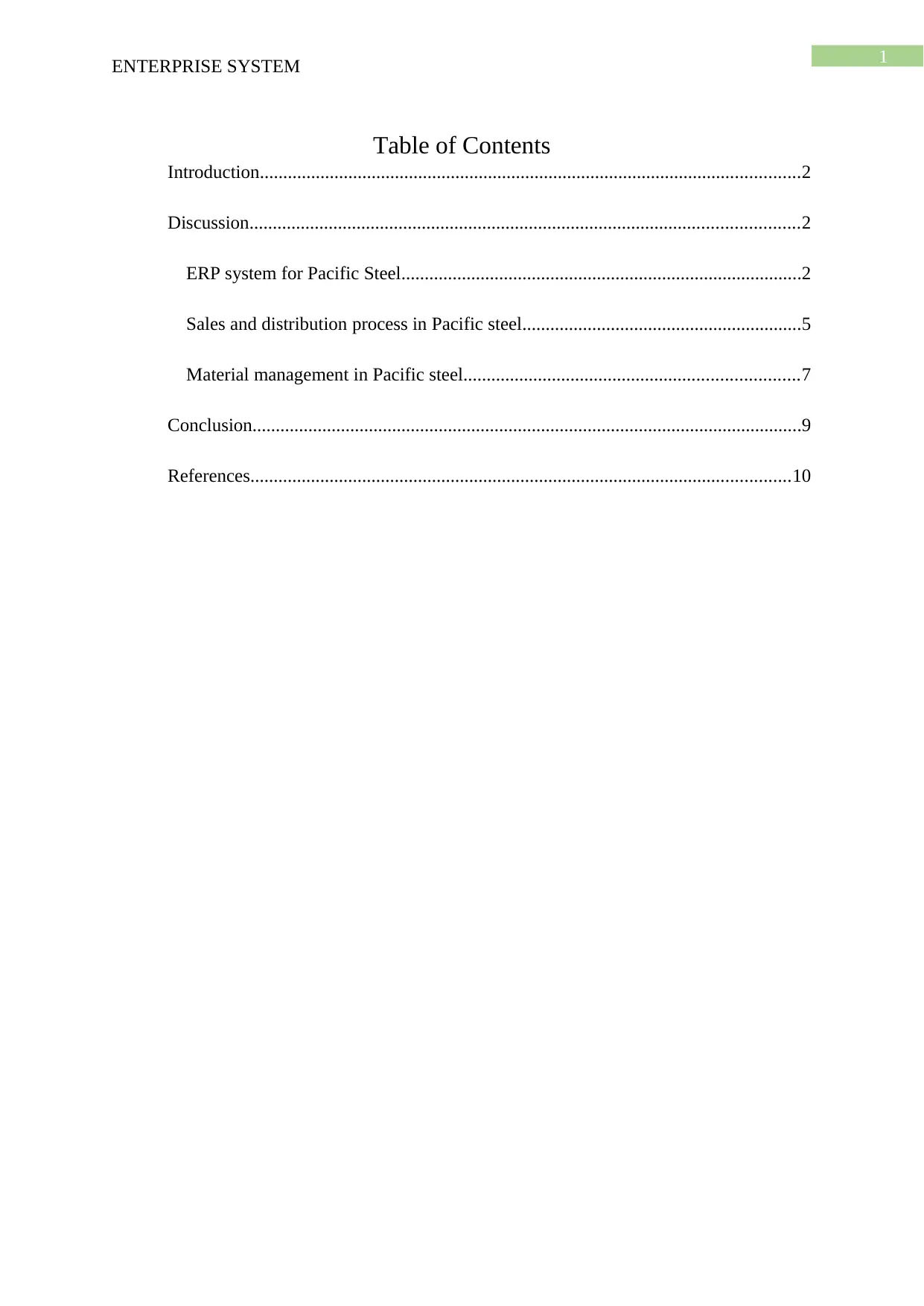
1
ENTERPRISE SYSTEM
Table of Contents
Introduction....................................................................................................................2
Discussion......................................................................................................................2
ERP system for Pacific Steel......................................................................................2
Sales and distribution process in Pacific steel............................................................5
Material management in Pacific steel........................................................................7
Conclusion......................................................................................................................9
References....................................................................................................................10
ENTERPRISE SYSTEM
Table of Contents
Introduction....................................................................................................................2
Discussion......................................................................................................................2
ERP system for Pacific Steel......................................................................................2
Sales and distribution process in Pacific steel............................................................5
Material management in Pacific steel........................................................................7
Conclusion......................................................................................................................9
References....................................................................................................................10
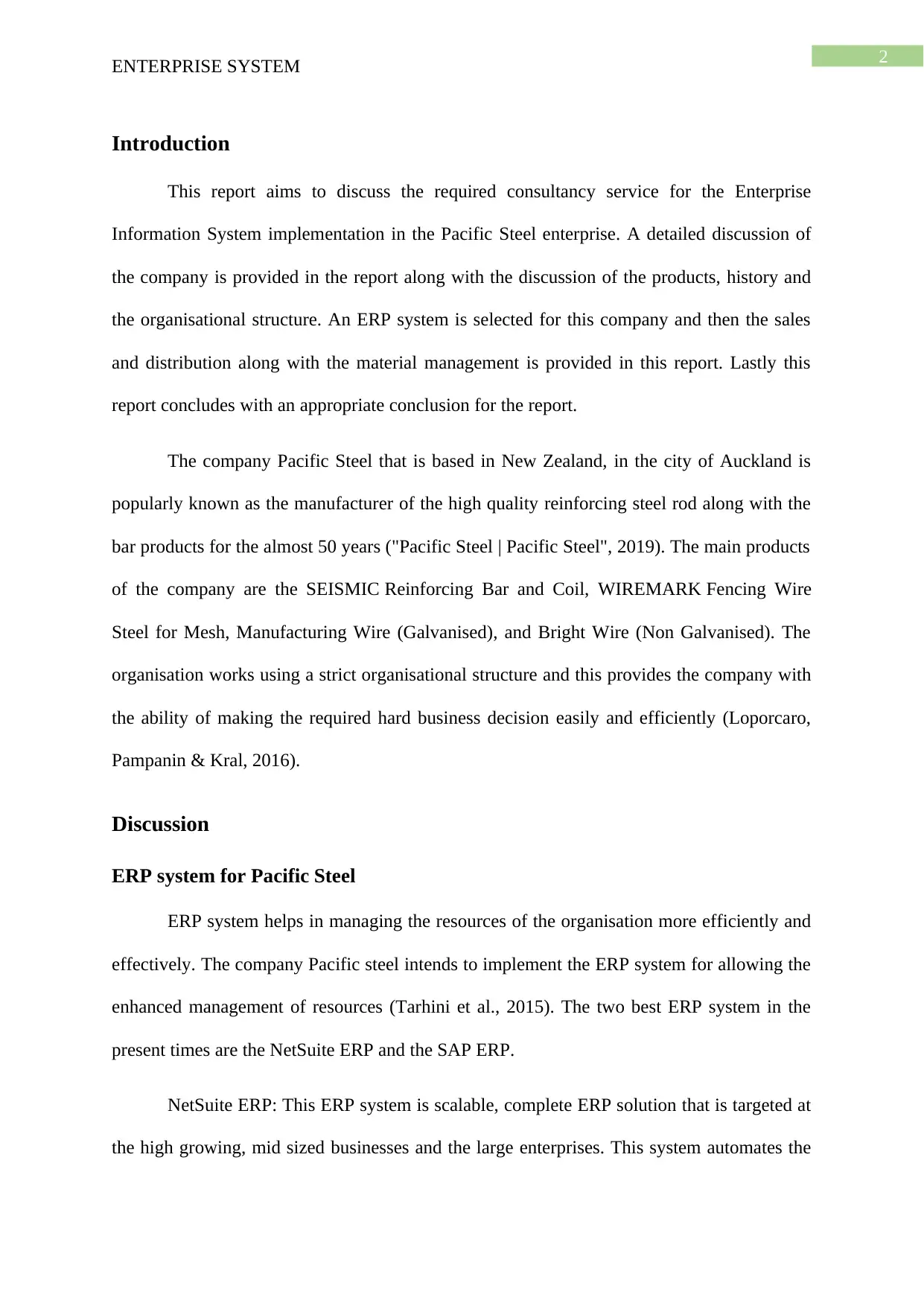
2
ENTERPRISE SYSTEM
Introduction
This report aims to discuss the required consultancy service for the Enterprise
Information System implementation in the Pacific Steel enterprise. A detailed discussion of
the company is provided in the report along with the discussion of the products, history and
the organisational structure. An ERP system is selected for this company and then the sales
and distribution along with the material management is provided in this report. Lastly this
report concludes with an appropriate conclusion for the report.
The company Pacific Steel that is based in New Zealand, in the city of Auckland is
popularly known as the manufacturer of the high quality reinforcing steel rod along with the
bar products for the almost 50 years ("Pacific Steel | Pacific Steel", 2019). The main products
of the company are the SEISMIC Reinforcing Bar and Coil, WIREMARK Fencing Wire
Steel for Mesh, Manufacturing Wire (Galvanised), and Bright Wire (Non Galvanised). The
organisation works using a strict organisational structure and this provides the company with
the ability of making the required hard business decision easily and efficiently (Loporcaro,
Pampanin & Kral, 2016).
Discussion
ERP system for Pacific Steel
ERP system helps in managing the resources of the organisation more efficiently and
effectively. The company Pacific steel intends to implement the ERP system for allowing the
enhanced management of resources (Tarhini et al., 2015). The two best ERP system in the
present times are the NetSuite ERP and the SAP ERP.
NetSuite ERP: This ERP system is scalable, complete ERP solution that is targeted at
the high growing, mid sized businesses and the large enterprises. This system automates the
ENTERPRISE SYSTEM
Introduction
This report aims to discuss the required consultancy service for the Enterprise
Information System implementation in the Pacific Steel enterprise. A detailed discussion of
the company is provided in the report along with the discussion of the products, history and
the organisational structure. An ERP system is selected for this company and then the sales
and distribution along with the material management is provided in this report. Lastly this
report concludes with an appropriate conclusion for the report.
The company Pacific Steel that is based in New Zealand, in the city of Auckland is
popularly known as the manufacturer of the high quality reinforcing steel rod along with the
bar products for the almost 50 years ("Pacific Steel | Pacific Steel", 2019). The main products
of the company are the SEISMIC Reinforcing Bar and Coil, WIREMARK Fencing Wire
Steel for Mesh, Manufacturing Wire (Galvanised), and Bright Wire (Non Galvanised). The
organisation works using a strict organisational structure and this provides the company with
the ability of making the required hard business decision easily and efficiently (Loporcaro,
Pampanin & Kral, 2016).
Discussion
ERP system for Pacific Steel
ERP system helps in managing the resources of the organisation more efficiently and
effectively. The company Pacific steel intends to implement the ERP system for allowing the
enhanced management of resources (Tarhini et al., 2015). The two best ERP system in the
present times are the NetSuite ERP and the SAP ERP.
NetSuite ERP: This ERP system is scalable, complete ERP solution that is targeted at
the high growing, mid sized businesses and the large enterprises. This system automates the
⊘ This is a preview!⊘
Do you want full access?
Subscribe today to unlock all pages.

Trusted by 1+ million students worldwide
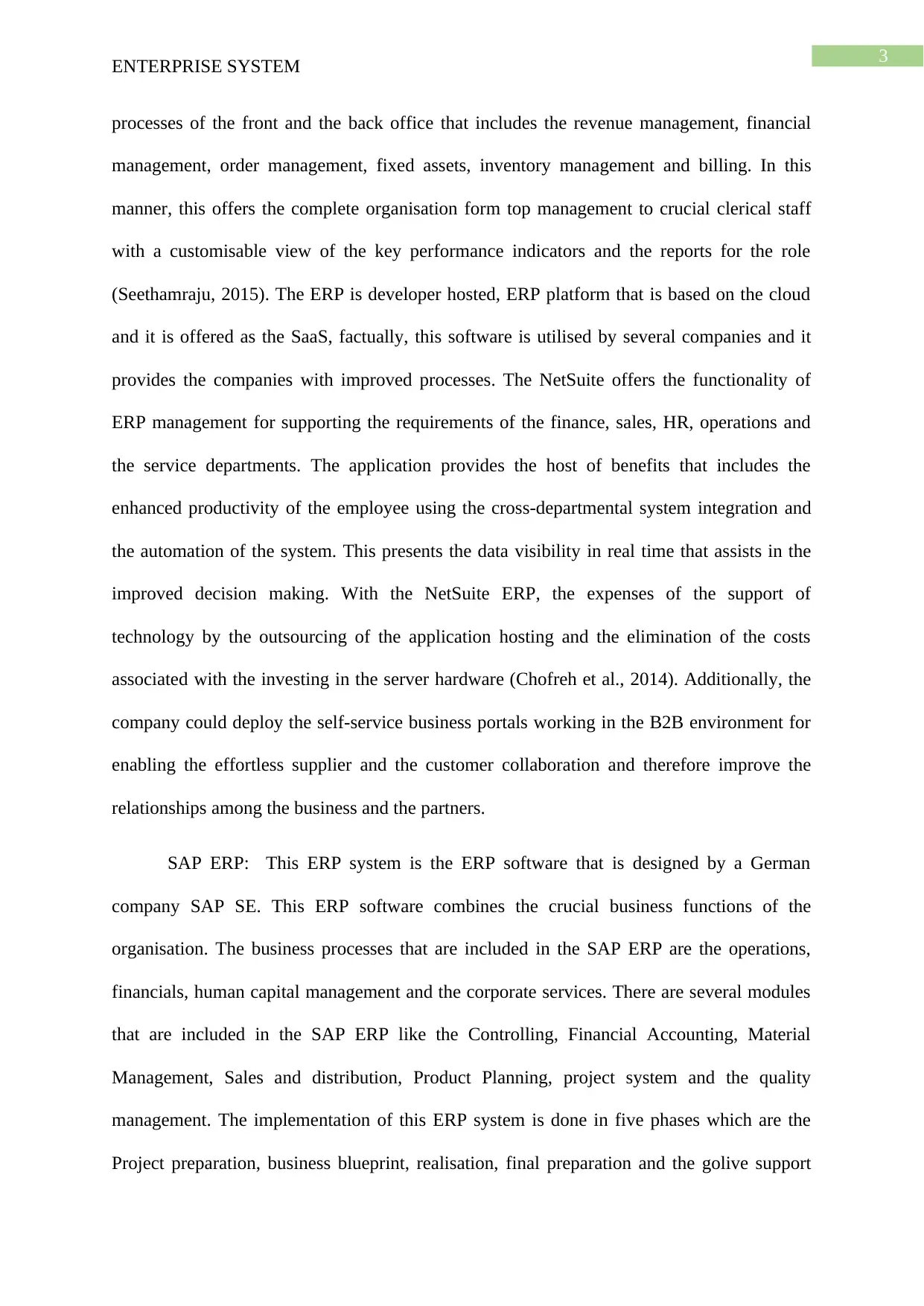
3
ENTERPRISE SYSTEM
processes of the front and the back office that includes the revenue management, financial
management, order management, fixed assets, inventory management and billing. In this
manner, this offers the complete organisation form top management to crucial clerical staff
with a customisable view of the key performance indicators and the reports for the role
(Seethamraju, 2015). The ERP is developer hosted, ERP platform that is based on the cloud
and it is offered as the SaaS, factually, this software is utilised by several companies and it
provides the companies with improved processes. The NetSuite offers the functionality of
ERP management for supporting the requirements of the finance, sales, HR, operations and
the service departments. The application provides the host of benefits that includes the
enhanced productivity of the employee using the cross-departmental system integration and
the automation of the system. This presents the data visibility in real time that assists in the
improved decision making. With the NetSuite ERP, the expenses of the support of
technology by the outsourcing of the application hosting and the elimination of the costs
associated with the investing in the server hardware (Chofreh et al., 2014). Additionally, the
company could deploy the self-service business portals working in the B2B environment for
enabling the effortless supplier and the customer collaboration and therefore improve the
relationships among the business and the partners.
SAP ERP: This ERP system is the ERP software that is designed by a German
company SAP SE. This ERP software combines the crucial business functions of the
organisation. The business processes that are included in the SAP ERP are the operations,
financials, human capital management and the corporate services. There are several modules
that are included in the SAP ERP like the Controlling, Financial Accounting, Material
Management, Sales and distribution, Product Planning, project system and the quality
management. The implementation of this ERP system is done in five phases which are the
Project preparation, business blueprint, realisation, final preparation and the golive support
ENTERPRISE SYSTEM
processes of the front and the back office that includes the revenue management, financial
management, order management, fixed assets, inventory management and billing. In this
manner, this offers the complete organisation form top management to crucial clerical staff
with a customisable view of the key performance indicators and the reports for the role
(Seethamraju, 2015). The ERP is developer hosted, ERP platform that is based on the cloud
and it is offered as the SaaS, factually, this software is utilised by several companies and it
provides the companies with improved processes. The NetSuite offers the functionality of
ERP management for supporting the requirements of the finance, sales, HR, operations and
the service departments. The application provides the host of benefits that includes the
enhanced productivity of the employee using the cross-departmental system integration and
the automation of the system. This presents the data visibility in real time that assists in the
improved decision making. With the NetSuite ERP, the expenses of the support of
technology by the outsourcing of the application hosting and the elimination of the costs
associated with the investing in the server hardware (Chofreh et al., 2014). Additionally, the
company could deploy the self-service business portals working in the B2B environment for
enabling the effortless supplier and the customer collaboration and therefore improve the
relationships among the business and the partners.
SAP ERP: This ERP system is the ERP software that is designed by a German
company SAP SE. This ERP software combines the crucial business functions of the
organisation. The business processes that are included in the SAP ERP are the operations,
financials, human capital management and the corporate services. There are several modules
that are included in the SAP ERP like the Controlling, Financial Accounting, Material
Management, Sales and distribution, Product Planning, project system and the quality
management. The implementation of this ERP system is done in five phases which are the
Project preparation, business blueprint, realisation, final preparation and the golive support
Paraphrase This Document
Need a fresh take? Get an instant paraphrase of this document with our AI Paraphraser
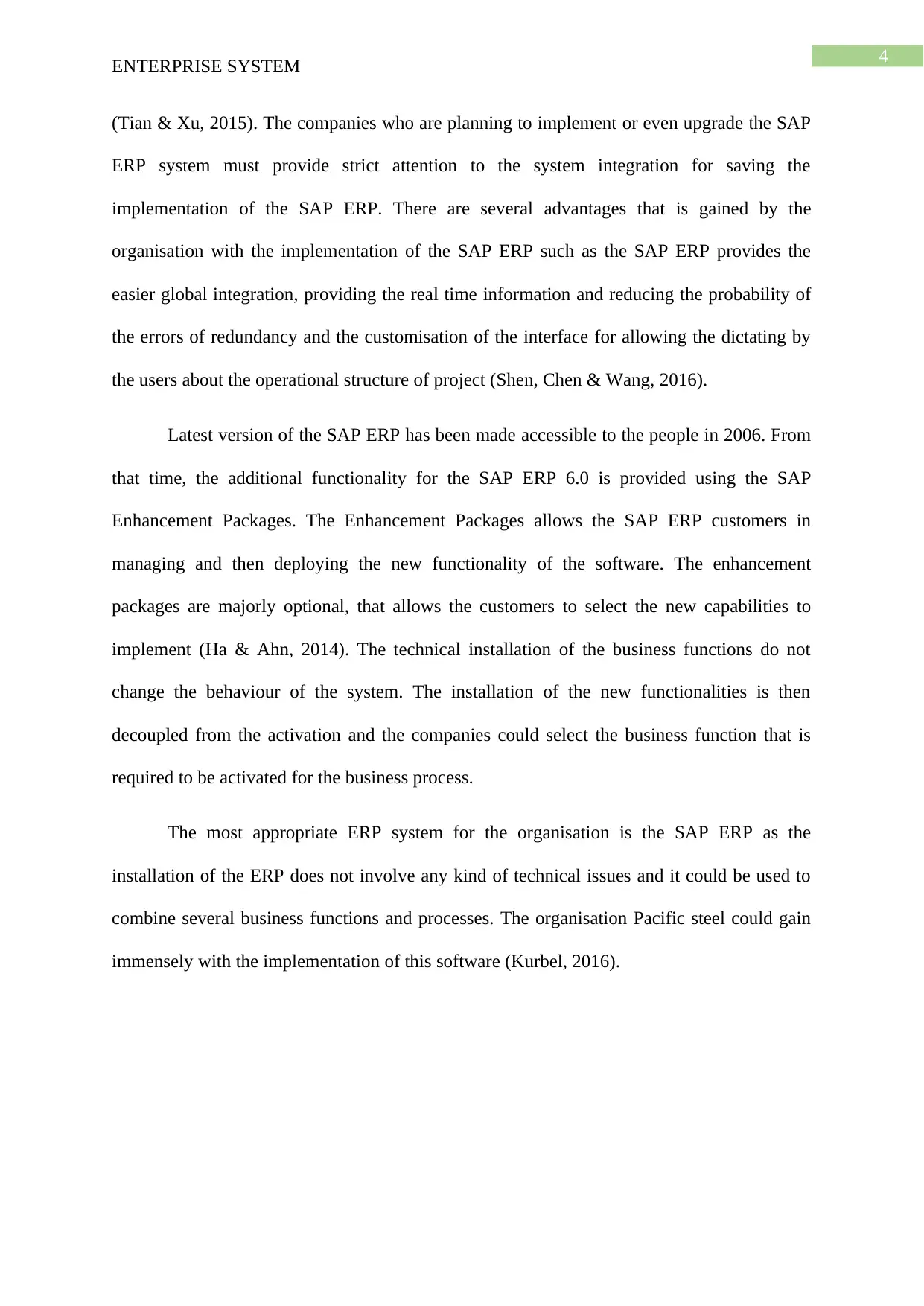
4
ENTERPRISE SYSTEM
(Tian & Xu, 2015). The companies who are planning to implement or even upgrade the SAP
ERP system must provide strict attention to the system integration for saving the
implementation of the SAP ERP. There are several advantages that is gained by the
organisation with the implementation of the SAP ERP such as the SAP ERP provides the
easier global integration, providing the real time information and reducing the probability of
the errors of redundancy and the customisation of the interface for allowing the dictating by
the users about the operational structure of project (Shen, Chen & Wang, 2016).
Latest version of the SAP ERP has been made accessible to the people in 2006. From
that time, the additional functionality for the SAP ERP 6.0 is provided using the SAP
Enhancement Packages. The Enhancement Packages allows the SAP ERP customers in
managing and then deploying the new functionality of the software. The enhancement
packages are majorly optional, that allows the customers to select the new capabilities to
implement (Ha & Ahn, 2014). The technical installation of the business functions do not
change the behaviour of the system. The installation of the new functionalities is then
decoupled from the activation and the companies could select the business function that is
required to be activated for the business process.
The most appropriate ERP system for the organisation is the SAP ERP as the
installation of the ERP does not involve any kind of technical issues and it could be used to
combine several business functions and processes. The organisation Pacific steel could gain
immensely with the implementation of this software (Kurbel, 2016).
ENTERPRISE SYSTEM
(Tian & Xu, 2015). The companies who are planning to implement or even upgrade the SAP
ERP system must provide strict attention to the system integration for saving the
implementation of the SAP ERP. There are several advantages that is gained by the
organisation with the implementation of the SAP ERP such as the SAP ERP provides the
easier global integration, providing the real time information and reducing the probability of
the errors of redundancy and the customisation of the interface for allowing the dictating by
the users about the operational structure of project (Shen, Chen & Wang, 2016).
Latest version of the SAP ERP has been made accessible to the people in 2006. From
that time, the additional functionality for the SAP ERP 6.0 is provided using the SAP
Enhancement Packages. The Enhancement Packages allows the SAP ERP customers in
managing and then deploying the new functionality of the software. The enhancement
packages are majorly optional, that allows the customers to select the new capabilities to
implement (Ha & Ahn, 2014). The technical installation of the business functions do not
change the behaviour of the system. The installation of the new functionalities is then
decoupled from the activation and the companies could select the business function that is
required to be activated for the business process.
The most appropriate ERP system for the organisation is the SAP ERP as the
installation of the ERP does not involve any kind of technical issues and it could be used to
combine several business functions and processes. The organisation Pacific steel could gain
immensely with the implementation of this software (Kurbel, 2016).
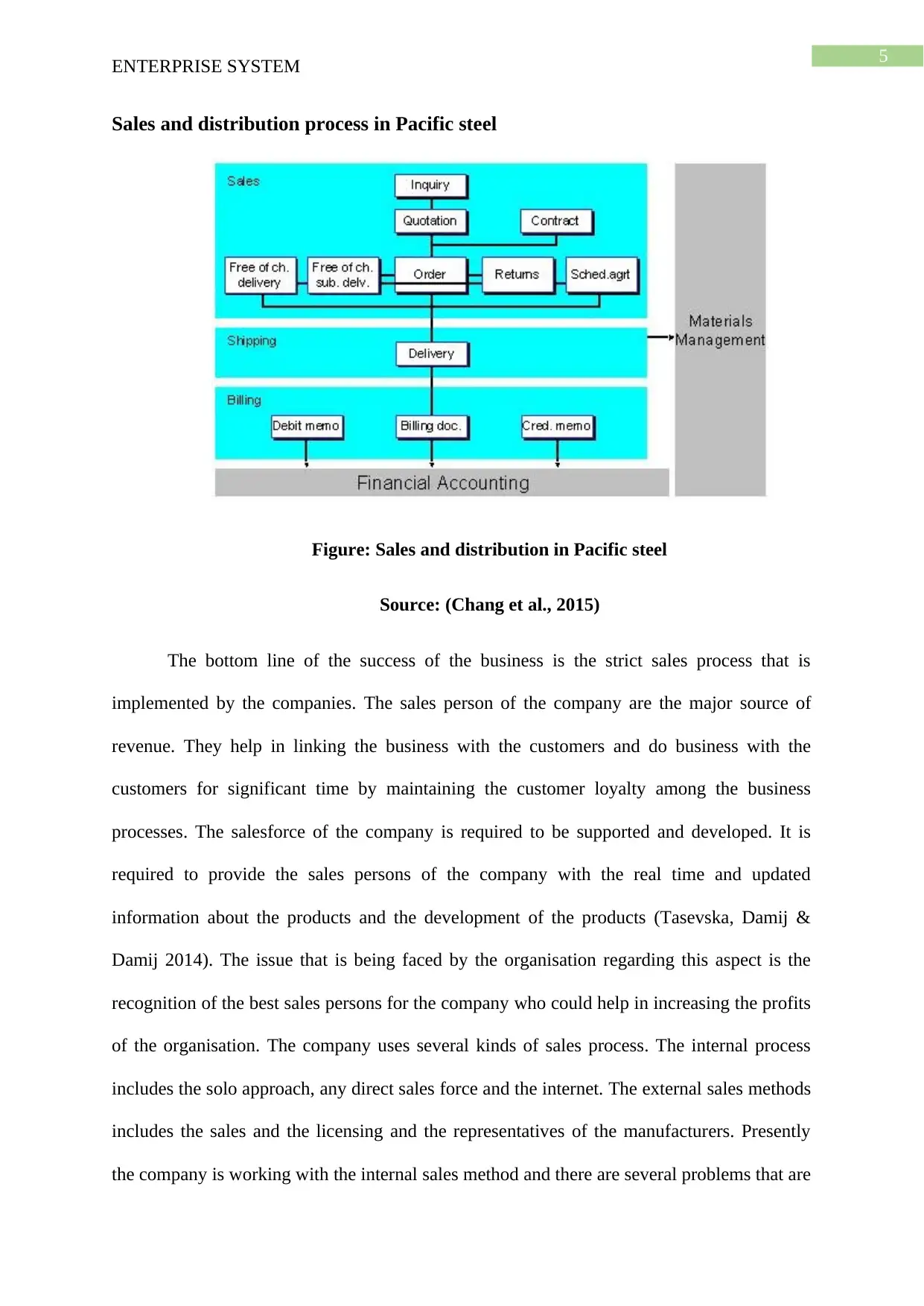
5
ENTERPRISE SYSTEM
Sales and distribution process in Pacific steel
Figure: Sales and distribution in Pacific steel
Source: (Chang et al., 2015)
The bottom line of the success of the business is the strict sales process that is
implemented by the companies. The sales person of the company are the major source of
revenue. They help in linking the business with the customers and do business with the
customers for significant time by maintaining the customer loyalty among the business
processes. The salesforce of the company is required to be supported and developed. It is
required to provide the sales persons of the company with the real time and updated
information about the products and the development of the products (Tasevska, Damij &
Damij 2014). The issue that is being faced by the organisation regarding this aspect is the
recognition of the best sales persons for the company who could help in increasing the profits
of the organisation. The company uses several kinds of sales process. The internal process
includes the solo approach, any direct sales force and the internet. The external sales methods
includes the sales and the licensing and the representatives of the manufacturers. Presently
the company is working with the internal sales method and there are several problems that are
ENTERPRISE SYSTEM
Sales and distribution process in Pacific steel
Figure: Sales and distribution in Pacific steel
Source: (Chang et al., 2015)
The bottom line of the success of the business is the strict sales process that is
implemented by the companies. The sales person of the company are the major source of
revenue. They help in linking the business with the customers and do business with the
customers for significant time by maintaining the customer loyalty among the business
processes. The salesforce of the company is required to be supported and developed. It is
required to provide the sales persons of the company with the real time and updated
information about the products and the development of the products (Tasevska, Damij &
Damij 2014). The issue that is being faced by the organisation regarding this aspect is the
recognition of the best sales persons for the company who could help in increasing the profits
of the organisation. The company uses several kinds of sales process. The internal process
includes the solo approach, any direct sales force and the internet. The external sales methods
includes the sales and the licensing and the representatives of the manufacturers. Presently
the company is working with the internal sales method and there are several problems that are
⊘ This is a preview!⊘
Do you want full access?
Subscribe today to unlock all pages.

Trusted by 1+ million students worldwide
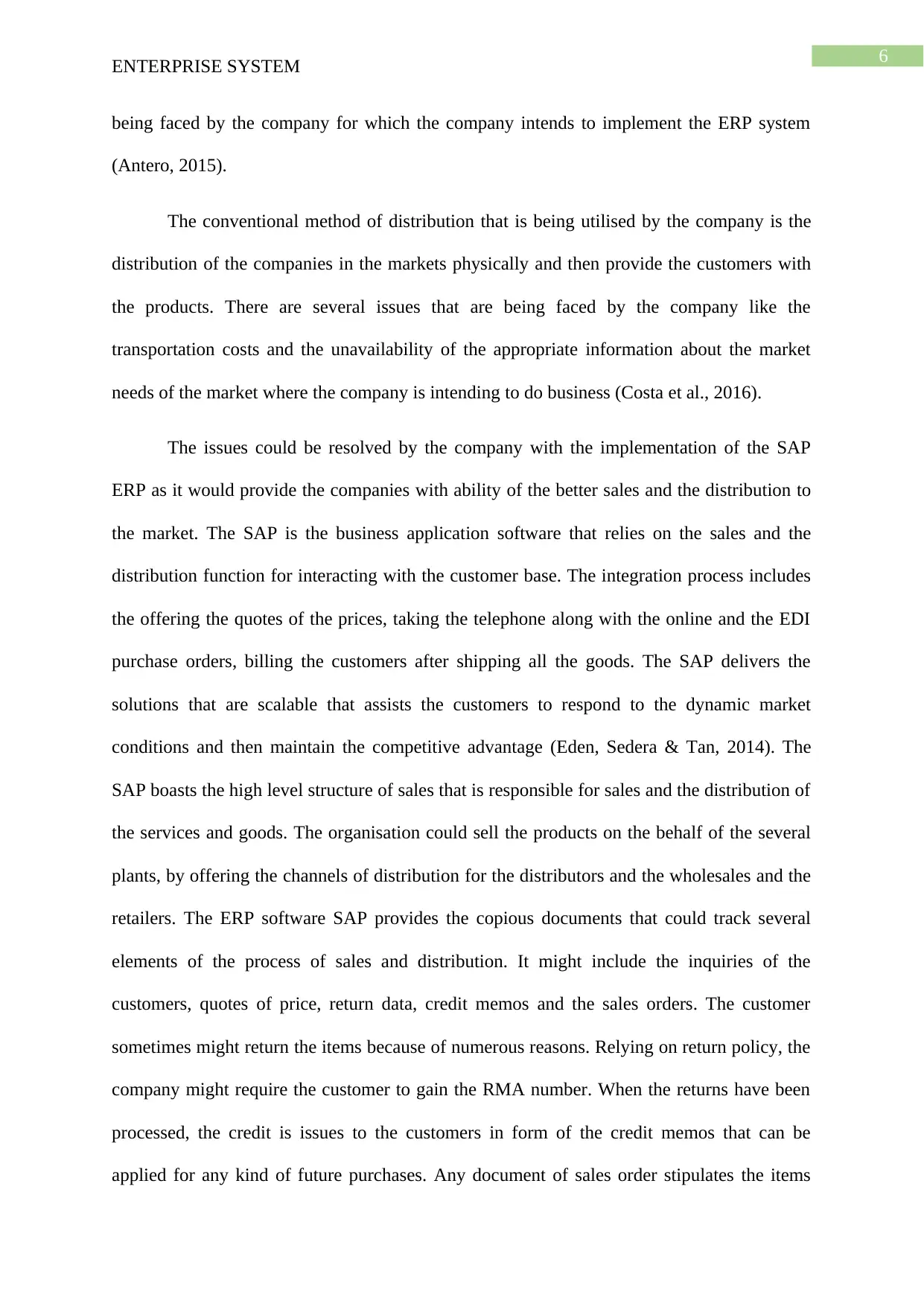
6
ENTERPRISE SYSTEM
being faced by the company for which the company intends to implement the ERP system
(Antero, 2015).
The conventional method of distribution that is being utilised by the company is the
distribution of the companies in the markets physically and then provide the customers with
the products. There are several issues that are being faced by the company like the
transportation costs and the unavailability of the appropriate information about the market
needs of the market where the company is intending to do business (Costa et al., 2016).
The issues could be resolved by the company with the implementation of the SAP
ERP as it would provide the companies with ability of the better sales and the distribution to
the market. The SAP is the business application software that relies on the sales and the
distribution function for interacting with the customer base. The integration process includes
the offering the quotes of the prices, taking the telephone along with the online and the EDI
purchase orders, billing the customers after shipping all the goods. The SAP delivers the
solutions that are scalable that assists the customers to respond to the dynamic market
conditions and then maintain the competitive advantage (Eden, Sedera & Tan, 2014). The
SAP boasts the high level structure of sales that is responsible for sales and the distribution of
the services and goods. The organisation could sell the products on the behalf of the several
plants, by offering the channels of distribution for the distributors and the wholesales and the
retailers. The ERP software SAP provides the copious documents that could track several
elements of the process of sales and distribution. It might include the inquiries of the
customers, quotes of price, return data, credit memos and the sales orders. The customer
sometimes might return the items because of numerous reasons. Relying on return policy, the
company might require the customer to gain the RMA number. When the returns have been
processed, the credit is issues to the customers in form of the credit memos that can be
applied for any kind of future purchases. Any document of sales order stipulates the items
ENTERPRISE SYSTEM
being faced by the company for which the company intends to implement the ERP system
(Antero, 2015).
The conventional method of distribution that is being utilised by the company is the
distribution of the companies in the markets physically and then provide the customers with
the products. There are several issues that are being faced by the company like the
transportation costs and the unavailability of the appropriate information about the market
needs of the market where the company is intending to do business (Costa et al., 2016).
The issues could be resolved by the company with the implementation of the SAP
ERP as it would provide the companies with ability of the better sales and the distribution to
the market. The SAP is the business application software that relies on the sales and the
distribution function for interacting with the customer base. The integration process includes
the offering the quotes of the prices, taking the telephone along with the online and the EDI
purchase orders, billing the customers after shipping all the goods. The SAP delivers the
solutions that are scalable that assists the customers to respond to the dynamic market
conditions and then maintain the competitive advantage (Eden, Sedera & Tan, 2014). The
SAP boasts the high level structure of sales that is responsible for sales and the distribution of
the services and goods. The organisation could sell the products on the behalf of the several
plants, by offering the channels of distribution for the distributors and the wholesales and the
retailers. The ERP software SAP provides the copious documents that could track several
elements of the process of sales and distribution. It might include the inquiries of the
customers, quotes of price, return data, credit memos and the sales orders. The customer
sometimes might return the items because of numerous reasons. Relying on return policy, the
company might require the customer to gain the RMA number. When the returns have been
processed, the credit is issues to the customers in form of the credit memos that can be
applied for any kind of future purchases. Any document of sales order stipulates the items
Paraphrase This Document
Need a fresh take? Get an instant paraphrase of this document with our AI Paraphraser
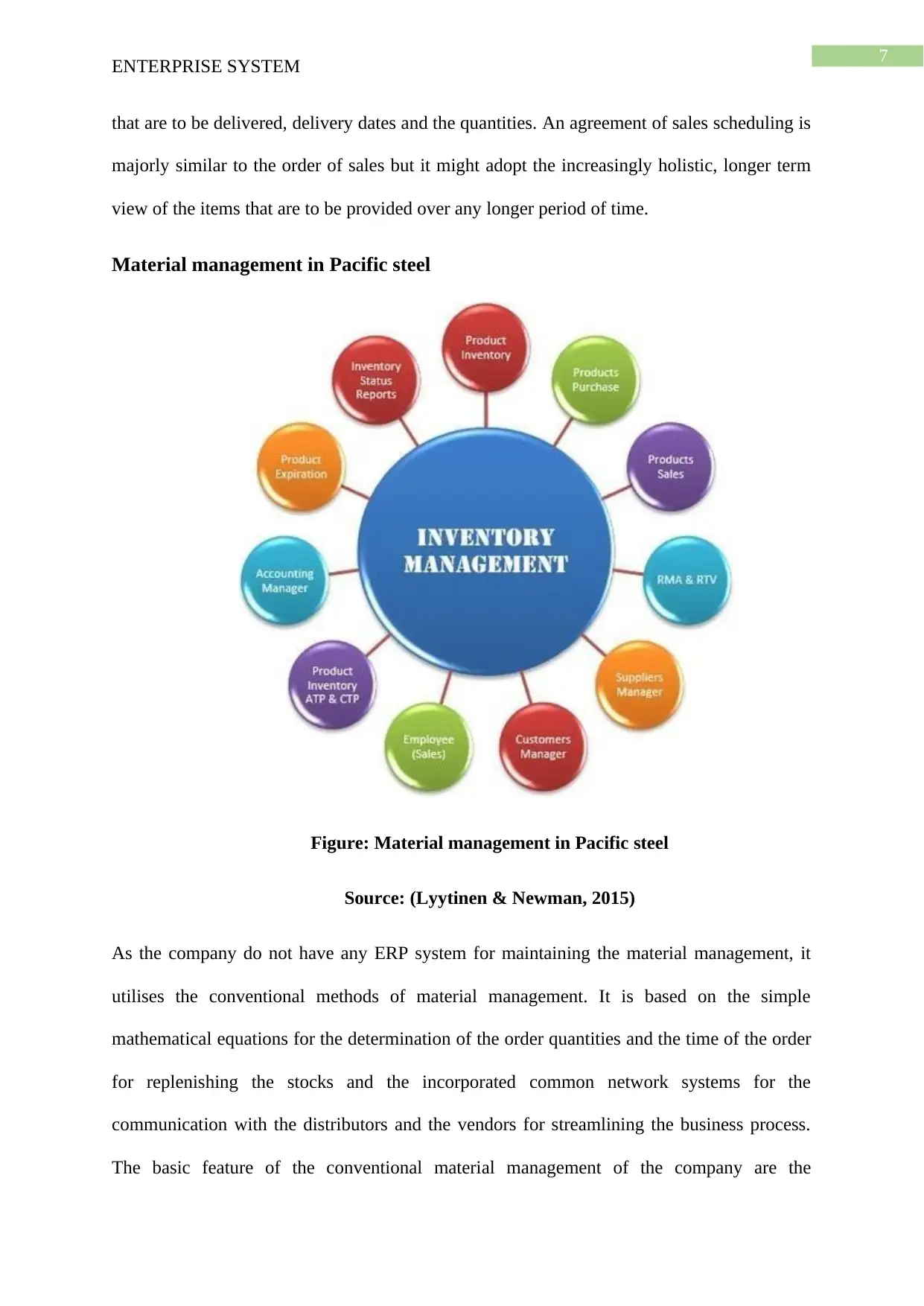
7
ENTERPRISE SYSTEM
that are to be delivered, delivery dates and the quantities. An agreement of sales scheduling is
majorly similar to the order of sales but it might adopt the increasingly holistic, longer term
view of the items that are to be provided over any longer period of time.
Material management in Pacific steel
Figure: Material management in Pacific steel
Source: (Lyytinen & Newman, 2015)
As the company do not have any ERP system for maintaining the material management, it
utilises the conventional methods of material management. It is based on the simple
mathematical equations for the determination of the order quantities and the time of the order
for replenishing the stocks and the incorporated common network systems for the
communication with the distributors and the vendors for streamlining the business process.
The basic feature of the conventional material management of the company are the
ENTERPRISE SYSTEM
that are to be delivered, delivery dates and the quantities. An agreement of sales scheduling is
majorly similar to the order of sales but it might adopt the increasingly holistic, longer term
view of the items that are to be provided over any longer period of time.
Material management in Pacific steel
Figure: Material management in Pacific steel
Source: (Lyytinen & Newman, 2015)
As the company do not have any ERP system for maintaining the material management, it
utilises the conventional methods of material management. It is based on the simple
mathematical equations for the determination of the order quantities and the time of the order
for replenishing the stocks and the incorporated common network systems for the
communication with the distributors and the vendors for streamlining the business process.
The basic feature of the conventional material management of the company are the
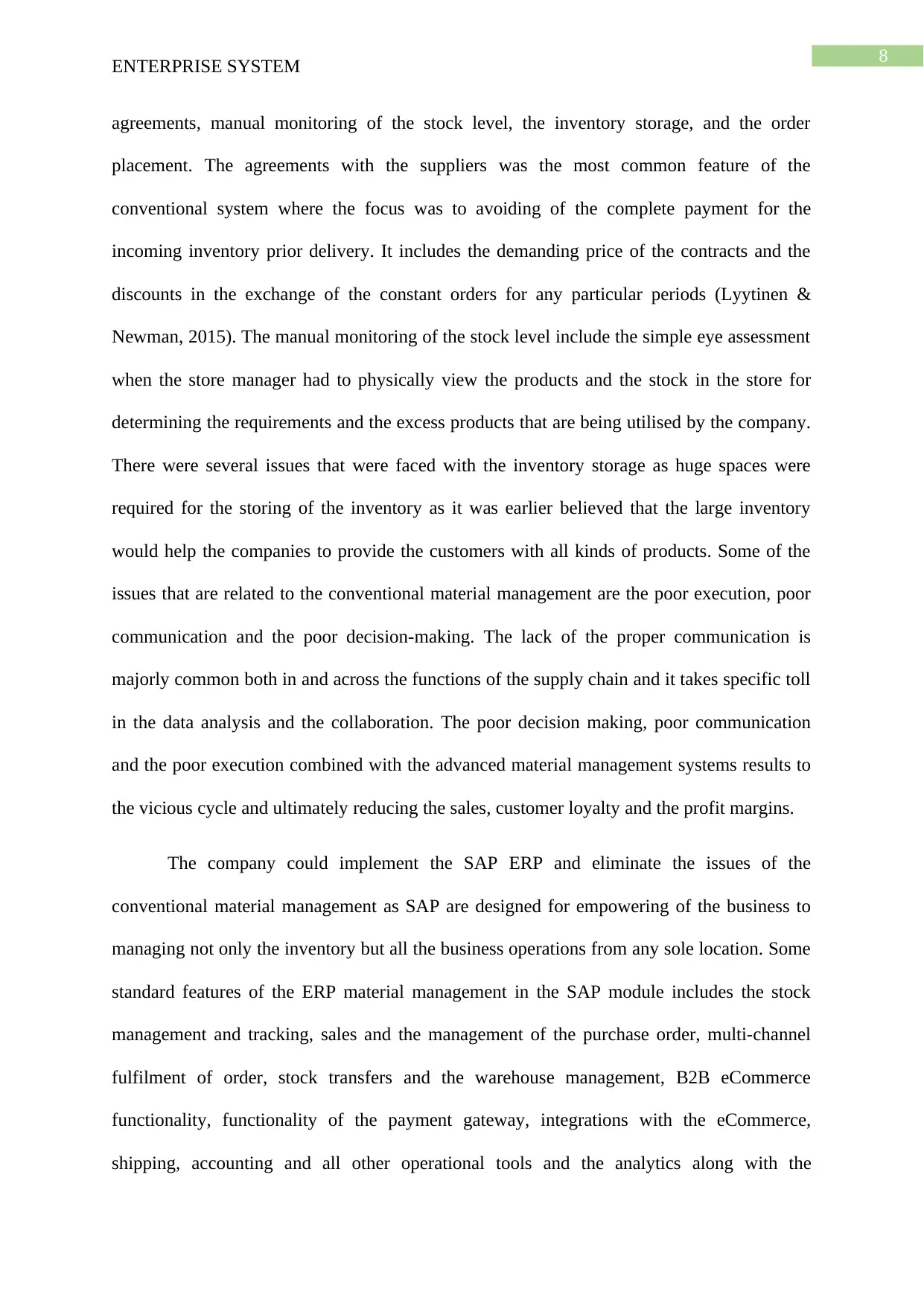
8
ENTERPRISE SYSTEM
agreements, manual monitoring of the stock level, the inventory storage, and the order
placement. The agreements with the suppliers was the most common feature of the
conventional system where the focus was to avoiding of the complete payment for the
incoming inventory prior delivery. It includes the demanding price of the contracts and the
discounts in the exchange of the constant orders for any particular periods (Lyytinen &
Newman, 2015). The manual monitoring of the stock level include the simple eye assessment
when the store manager had to physically view the products and the stock in the store for
determining the requirements and the excess products that are being utilised by the company.
There were several issues that were faced with the inventory storage as huge spaces were
required for the storing of the inventory as it was earlier believed that the large inventory
would help the companies to provide the customers with all kinds of products. Some of the
issues that are related to the conventional material management are the poor execution, poor
communication and the poor decision-making. The lack of the proper communication is
majorly common both in and across the functions of the supply chain and it takes specific toll
in the data analysis and the collaboration. The poor decision making, poor communication
and the poor execution combined with the advanced material management systems results to
the vicious cycle and ultimately reducing the sales, customer loyalty and the profit margins.
The company could implement the SAP ERP and eliminate the issues of the
conventional material management as SAP are designed for empowering of the business to
managing not only the inventory but all the business operations from any sole location. Some
standard features of the ERP material management in the SAP module includes the stock
management and tracking, sales and the management of the purchase order, multi-channel
fulfilment of order, stock transfers and the warehouse management, B2B eCommerce
functionality, functionality of the payment gateway, integrations with the eCommerce,
shipping, accounting and all other operational tools and the analytics along with the
ENTERPRISE SYSTEM
agreements, manual monitoring of the stock level, the inventory storage, and the order
placement. The agreements with the suppliers was the most common feature of the
conventional system where the focus was to avoiding of the complete payment for the
incoming inventory prior delivery. It includes the demanding price of the contracts and the
discounts in the exchange of the constant orders for any particular periods (Lyytinen &
Newman, 2015). The manual monitoring of the stock level include the simple eye assessment
when the store manager had to physically view the products and the stock in the store for
determining the requirements and the excess products that are being utilised by the company.
There were several issues that were faced with the inventory storage as huge spaces were
required for the storing of the inventory as it was earlier believed that the large inventory
would help the companies to provide the customers with all kinds of products. Some of the
issues that are related to the conventional material management are the poor execution, poor
communication and the poor decision-making. The lack of the proper communication is
majorly common both in and across the functions of the supply chain and it takes specific toll
in the data analysis and the collaboration. The poor decision making, poor communication
and the poor execution combined with the advanced material management systems results to
the vicious cycle and ultimately reducing the sales, customer loyalty and the profit margins.
The company could implement the SAP ERP and eliminate the issues of the
conventional material management as SAP are designed for empowering of the business to
managing not only the inventory but all the business operations from any sole location. Some
standard features of the ERP material management in the SAP module includes the stock
management and tracking, sales and the management of the purchase order, multi-channel
fulfilment of order, stock transfers and the warehouse management, B2B eCommerce
functionality, functionality of the payment gateway, integrations with the eCommerce,
shipping, accounting and all other operational tools and the analytics along with the
⊘ This is a preview!⊘
Do you want full access?
Subscribe today to unlock all pages.

Trusted by 1+ million students worldwide
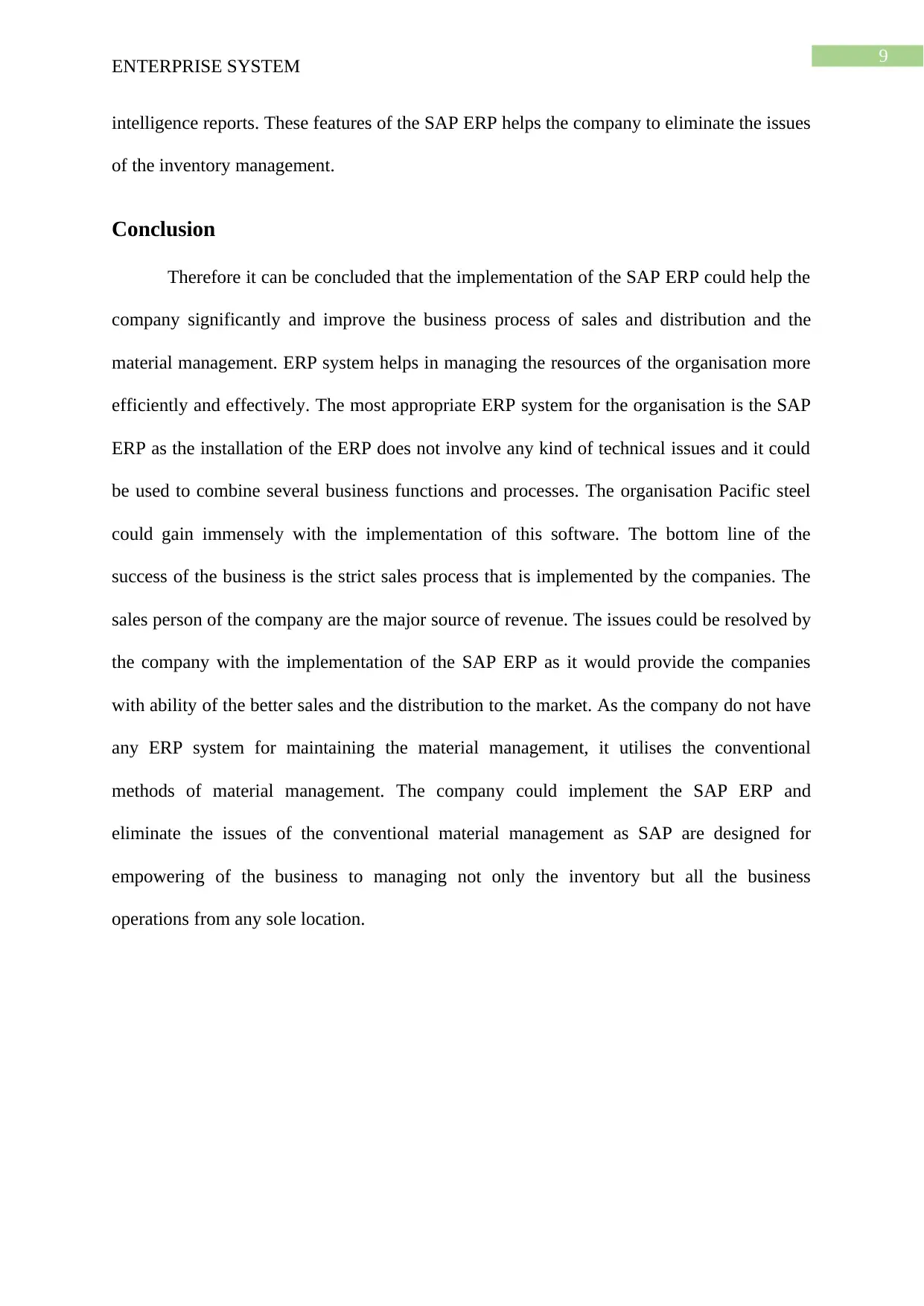
9
ENTERPRISE SYSTEM
intelligence reports. These features of the SAP ERP helps the company to eliminate the issues
of the inventory management.
Conclusion
Therefore it can be concluded that the implementation of the SAP ERP could help the
company significantly and improve the business process of sales and distribution and the
material management. ERP system helps in managing the resources of the organisation more
efficiently and effectively. The most appropriate ERP system for the organisation is the SAP
ERP as the installation of the ERP does not involve any kind of technical issues and it could
be used to combine several business functions and processes. The organisation Pacific steel
could gain immensely with the implementation of this software. The bottom line of the
success of the business is the strict sales process that is implemented by the companies. The
sales person of the company are the major source of revenue. The issues could be resolved by
the company with the implementation of the SAP ERP as it would provide the companies
with ability of the better sales and the distribution to the market. As the company do not have
any ERP system for maintaining the material management, it utilises the conventional
methods of material management. The company could implement the SAP ERP and
eliminate the issues of the conventional material management as SAP are designed for
empowering of the business to managing not only the inventory but all the business
operations from any sole location.
ENTERPRISE SYSTEM
intelligence reports. These features of the SAP ERP helps the company to eliminate the issues
of the inventory management.
Conclusion
Therefore it can be concluded that the implementation of the SAP ERP could help the
company significantly and improve the business process of sales and distribution and the
material management. ERP system helps in managing the resources of the organisation more
efficiently and effectively. The most appropriate ERP system for the organisation is the SAP
ERP as the installation of the ERP does not involve any kind of technical issues and it could
be used to combine several business functions and processes. The organisation Pacific steel
could gain immensely with the implementation of this software. The bottom line of the
success of the business is the strict sales process that is implemented by the companies. The
sales person of the company are the major source of revenue. The issues could be resolved by
the company with the implementation of the SAP ERP as it would provide the companies
with ability of the better sales and the distribution to the market. As the company do not have
any ERP system for maintaining the material management, it utilises the conventional
methods of material management. The company could implement the SAP ERP and
eliminate the issues of the conventional material management as SAP are designed for
empowering of the business to managing not only the inventory but all the business
operations from any sole location.
Paraphrase This Document
Need a fresh take? Get an instant paraphrase of this document with our AI Paraphraser
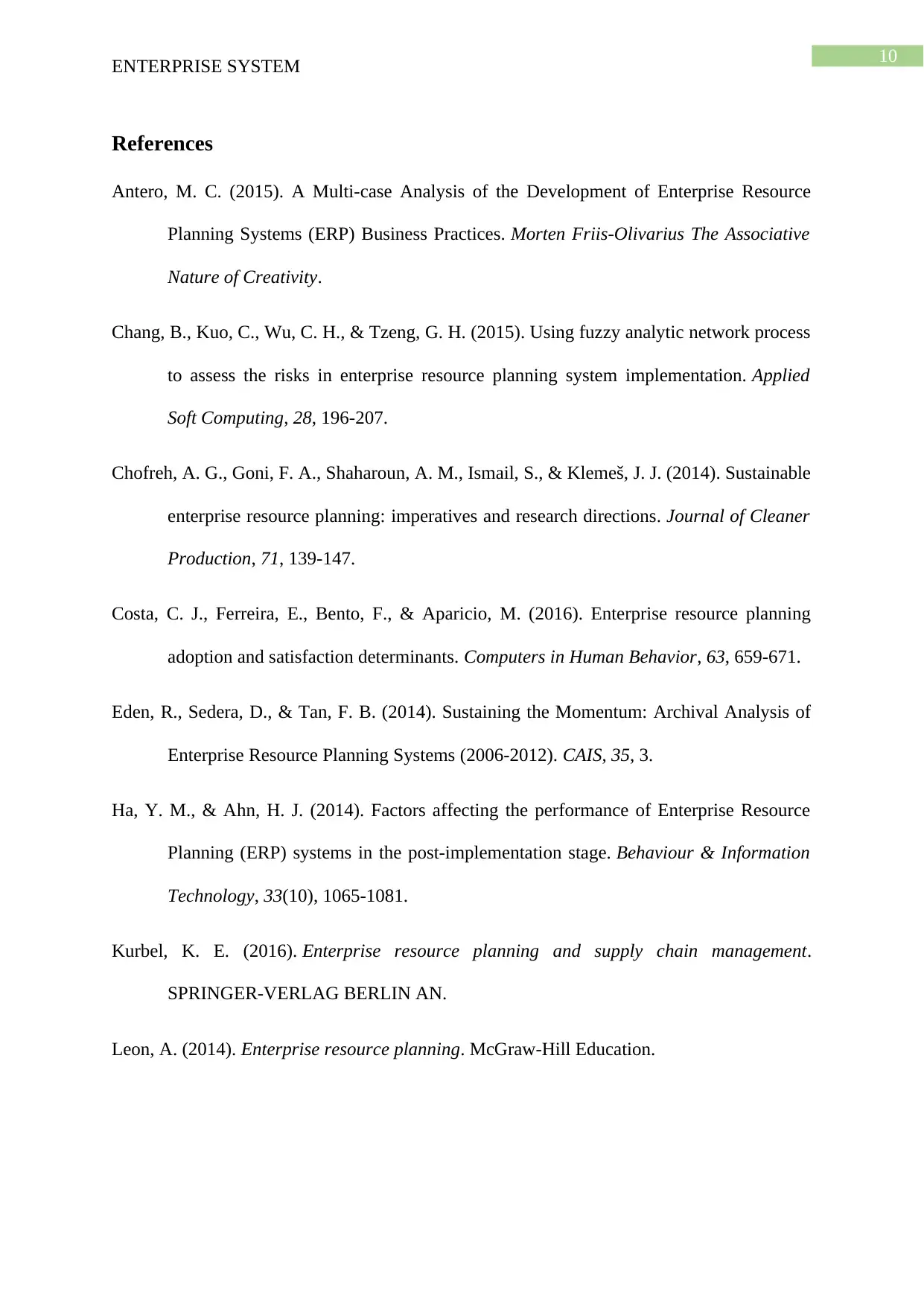
10
ENTERPRISE SYSTEM
References
Antero, M. C. (2015). A Multi-case Analysis of the Development of Enterprise Resource
Planning Systems (ERP) Business Practices. Morten Friis-Olivarius The Associative
Nature of Creativity.
Chang, B., Kuo, C., Wu, C. H., & Tzeng, G. H. (2015). Using fuzzy analytic network process
to assess the risks in enterprise resource planning system implementation. Applied
Soft Computing, 28, 196-207.
Chofreh, A. G., Goni, F. A., Shaharoun, A. M., Ismail, S., & Klemeš, J. J. (2014). Sustainable
enterprise resource planning: imperatives and research directions. Journal of Cleaner
Production, 71, 139-147.
Costa, C. J., Ferreira, E., Bento, F., & Aparicio, M. (2016). Enterprise resource planning
adoption and satisfaction determinants. Computers in Human Behavior, 63, 659-671.
Eden, R., Sedera, D., & Tan, F. B. (2014). Sustaining the Momentum: Archival Analysis of
Enterprise Resource Planning Systems (2006-2012). CAIS, 35, 3.
Ha, Y. M., & Ahn, H. J. (2014). Factors affecting the performance of Enterprise Resource
Planning (ERP) systems in the post-implementation stage. Behaviour & Information
Technology, 33(10), 1065-1081.
Kurbel, K. E. (2016). Enterprise resource planning and supply chain management.
SPRINGER-VERLAG BERLIN AN.
Leon, A. (2014). Enterprise resource planning. McGraw-Hill Education.
ENTERPRISE SYSTEM
References
Antero, M. C. (2015). A Multi-case Analysis of the Development of Enterprise Resource
Planning Systems (ERP) Business Practices. Morten Friis-Olivarius The Associative
Nature of Creativity.
Chang, B., Kuo, C., Wu, C. H., & Tzeng, G. H. (2015). Using fuzzy analytic network process
to assess the risks in enterprise resource planning system implementation. Applied
Soft Computing, 28, 196-207.
Chofreh, A. G., Goni, F. A., Shaharoun, A. M., Ismail, S., & Klemeš, J. J. (2014). Sustainable
enterprise resource planning: imperatives and research directions. Journal of Cleaner
Production, 71, 139-147.
Costa, C. J., Ferreira, E., Bento, F., & Aparicio, M. (2016). Enterprise resource planning
adoption and satisfaction determinants. Computers in Human Behavior, 63, 659-671.
Eden, R., Sedera, D., & Tan, F. B. (2014). Sustaining the Momentum: Archival Analysis of
Enterprise Resource Planning Systems (2006-2012). CAIS, 35, 3.
Ha, Y. M., & Ahn, H. J. (2014). Factors affecting the performance of Enterprise Resource
Planning (ERP) systems in the post-implementation stage. Behaviour & Information
Technology, 33(10), 1065-1081.
Kurbel, K. E. (2016). Enterprise resource planning and supply chain management.
SPRINGER-VERLAG BERLIN AN.
Leon, A. (2014). Enterprise resource planning. McGraw-Hill Education.
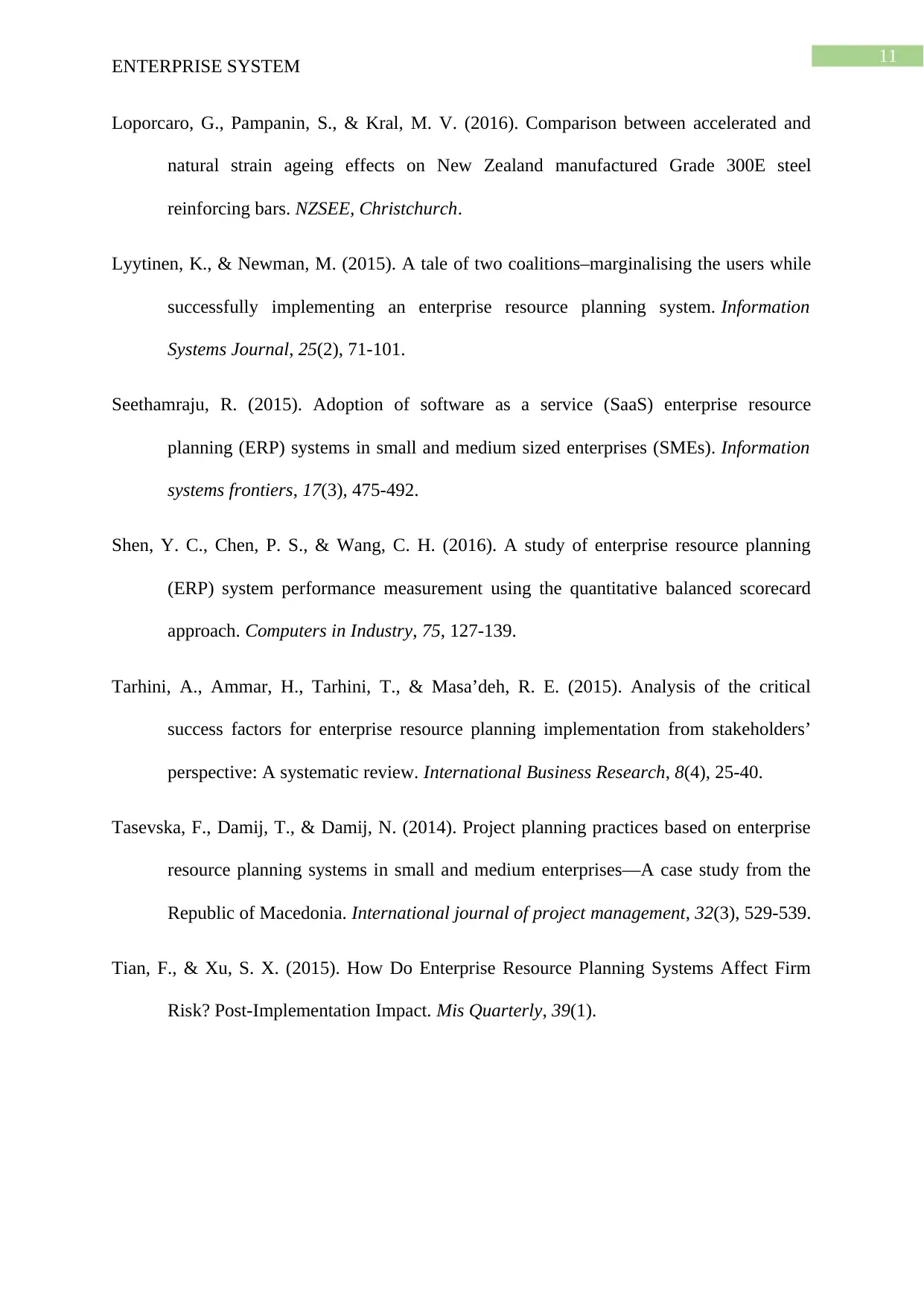
11
ENTERPRISE SYSTEM
Loporcaro, G., Pampanin, S., & Kral, M. V. (2016). Comparison between accelerated and
natural strain ageing effects on New Zealand manufactured Grade 300E steel
reinforcing bars. NZSEE, Christchurch.
Lyytinen, K., & Newman, M. (2015). A tale of two coalitions–marginalising the users while
successfully implementing an enterprise resource planning system. Information
Systems Journal, 25(2), 71-101.
Seethamraju, R. (2015). Adoption of software as a service (SaaS) enterprise resource
planning (ERP) systems in small and medium sized enterprises (SMEs). Information
systems frontiers, 17(3), 475-492.
Shen, Y. C., Chen, P. S., & Wang, C. H. (2016). A study of enterprise resource planning
(ERP) system performance measurement using the quantitative balanced scorecard
approach. Computers in Industry, 75, 127-139.
Tarhini, A., Ammar, H., Tarhini, T., & Masa’deh, R. E. (2015). Analysis of the critical
success factors for enterprise resource planning implementation from stakeholders’
perspective: A systematic review. International Business Research, 8(4), 25-40.
Tasevska, F., Damij, T., & Damij, N. (2014). Project planning practices based on enterprise
resource planning systems in small and medium enterprises—A case study from the
Republic of Macedonia. International journal of project management, 32(3), 529-539.
Tian, F., & Xu, S. X. (2015). How Do Enterprise Resource Planning Systems Affect Firm
Risk? Post-Implementation Impact. Mis Quarterly, 39(1).
ENTERPRISE SYSTEM
Loporcaro, G., Pampanin, S., & Kral, M. V. (2016). Comparison between accelerated and
natural strain ageing effects on New Zealand manufactured Grade 300E steel
reinforcing bars. NZSEE, Christchurch.
Lyytinen, K., & Newman, M. (2015). A tale of two coalitions–marginalising the users while
successfully implementing an enterprise resource planning system. Information
Systems Journal, 25(2), 71-101.
Seethamraju, R. (2015). Adoption of software as a service (SaaS) enterprise resource
planning (ERP) systems in small and medium sized enterprises (SMEs). Information
systems frontiers, 17(3), 475-492.
Shen, Y. C., Chen, P. S., & Wang, C. H. (2016). A study of enterprise resource planning
(ERP) system performance measurement using the quantitative balanced scorecard
approach. Computers in Industry, 75, 127-139.
Tarhini, A., Ammar, H., Tarhini, T., & Masa’deh, R. E. (2015). Analysis of the critical
success factors for enterprise resource planning implementation from stakeholders’
perspective: A systematic review. International Business Research, 8(4), 25-40.
Tasevska, F., Damij, T., & Damij, N. (2014). Project planning practices based on enterprise
resource planning systems in small and medium enterprises—A case study from the
Republic of Macedonia. International journal of project management, 32(3), 529-539.
Tian, F., & Xu, S. X. (2015). How Do Enterprise Resource Planning Systems Affect Firm
Risk? Post-Implementation Impact. Mis Quarterly, 39(1).
⊘ This is a preview!⊘
Do you want full access?
Subscribe today to unlock all pages.

Trusted by 1+ million students worldwide
1 out of 12
Related Documents
Your All-in-One AI-Powered Toolkit for Academic Success.
+13062052269
info@desklib.com
Available 24*7 on WhatsApp / Email
![[object Object]](/_next/static/media/star-bottom.7253800d.svg)
Unlock your academic potential
Copyright © 2020–2025 A2Z Services. All Rights Reserved. Developed and managed by ZUCOL.





